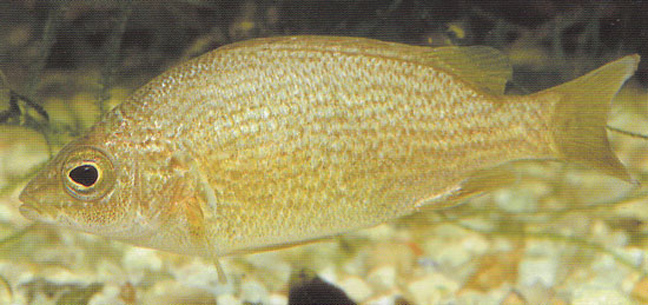Fortescue Grunter, Leiopotherapon aheneus (Mees 1963)

Fortescue Grunter, Leiopotherapon aheneus. Source: Gerald R. Allen. License: all rights reserved
Fortescue Grunter, Leiopotherapon aheneus (Mees 1963)
More Info
|
Distribution |
Known only from the Ashburton River (22º45´S) to upper reaches of the Fortescue River (22º15´S), in the pilbarra region of Western Australia. Inhabits slow to fast flowing clear freshwater streams and pools over sandy and rocky bottoms. |
|
Features |
Meristic features: Dorsal fin XI-XIII, 8-9; Anal fin III, 8-9; Pectoral fin 13-14; Pelvic fin I, 5; Lateral line scales 40-45; Transverse scales 5-6/1/14-15; Gill rakers 6-8+1+11-12; Vertebrae 10+15. Body moderately deep, 2.4-2.6 in SL, ovate, moderately compressed; dorsal profile more pronounced than ventral, straight or slightly convex to nape, then convex to dorsal origin; ventral profile slightly convex from lower lip to pelvic insertion, straight from insertion to anus. Head length 2.7-3.0 in SL; snout length 3.1-3.9 in HL. Nostrils separated by a distance equal to one-half diameter of eye. Eye width 3.2-4.0 in HL. Inter-orbital region with ridges. Jaws equal, length 2.7-3.5 in HL; gape oblique; maxillary reaching to vertical through anterior of eye; teeth conic, outer row enlarged, followed by a band of smaller teeth; no teeth on vomer or palatines. Lacrimal with 3-4 small serrations. Preoperculum serrate; serrations larger on angle. Lower opercular spine stronger and longer; not extending beyond edge of opercular lobe. Posttemporal not exposed; covered with skin and scales; covering of scales reduced in some specimens. Cleithrum exposed; serrate along posterior edge; scales on side. Supracleithrum exposed. Scales finely ctenoid; lateral line continuous, smoothly curved; 12-14 predorsal scales to occiput; one row of scales in sheath at base of dorsal fin, sheath extending to second dorsal ray; two rows of scales in sheath at base of anal fin, sheath extending to third or fourth anal ray; cheek scales in 4-5 rows. Dorsal fin continuous, base of dorsal 1.9-2.0 in SL; spinous portion arched, fifth spine longest, 2.1-2.4 in HL, following spines decreasing in length to last; longest dorsal rays shorter than longest dorsal spines, longest dorsal ray 2.2-2.5 in HL, soft dorsal rounded. Second anal spine strongest and longest, 2.3-2.7 in HL, twice length of first and slightly longer than third, longest anal spine shorter than longest anal rays, longest anal ray 2.1-2.3 in HL, soft anal rounded. Pectoral fins asymmetrically pointed; fourth ray longest. Ventral fins pointed; first ray longest or equal to second, reaching three-quarters of distance to anus. Caudal fin emarginate. |
|
Size |
To 13 cm SL, commonly to 8cm. |
|
Colour |
Bronze, with vertical bars in young. Body brown to blackish with 10-15 irregular longitudinal vermiculations variably present. Intensity of coloration varying between drainages. Head dark dorsally, pale ventrally. Dorsal fin clear to dusky. Anal fin slightly dusky. Caudal fin darker basally, slightly dusky at edge, especially on upper lobe. Pectoral and pelvic fins clear to dusky. |
|
Feeding |
Feed on small crustaceans and small fishes. |
|
Biology |
Little is known of the reproductive biology of this species, but is likely to produce demersal eggs. |
|
Etymology |
Leiopotherapon is from the Greek, leios, meaning 'smooth', omos meaning 'shoulder', and Therapon, a genus of the family, in reference to the lack of an exposed serrate post-temporal considered to be characteristic of the species in this genus. The specific name aheneus is from the poetic aspirated form of the Latin aeneus for bronzy or brassy, and refers to the bronze life coloration of this species. |
|
Species Citation |
Therapon aheneus Mees, 1963, J. R. Soc. West. Aust. 46(1): 2. Type locality: Millstream Pool, WA. |
|
Author |
Martin F. Gomon |
Fortescue Grunter, Leiopotherapon aheneus (Mees 1963)
References
Allen, G.R. (1982). Inland Fishes of Western Australia. Perth : Western Australian Museum 86 pp. 6 figs 20 pls [48].
Allen, G.R., Midgley, S.H. & Allen, M. (2002). Field guide to the freshwater fishes of Australia. Perth : Western Australian Museum 394 pp.
Lake, J.S. (1978). Australian Freshwater Fishes. Melbourne : Thomas Nelson 160 pp. 140 figs (as Mesopristes aheneus).
Mees, G.F. (1963). Description of a new freshwater fish of the family Theraponidae from Western Australia. J. R. Soc. West. Aust. 46(1): 1–4 fig. 1
Vari, R.P. (1978). The terapon perches (Percoidei, Terapontidae) a cladistic analysis and taxonomic revision. Bull. Amer. Mus. Nat. Hist. 159(5): 175–340 figs 1–94.

